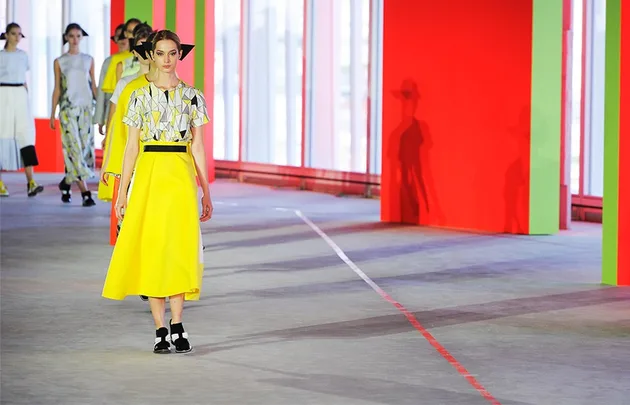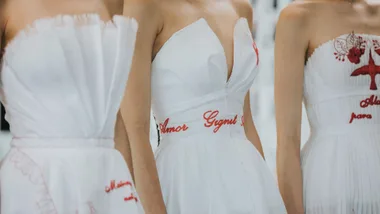In a glass-fronted office block high above London’s River Thames, Roksanda Ilincic’s catwalk show is reaching its finale. The front row applauds as an eye-watering parade of sharp lemon and tangerine dresses punctuate the runway’s neutral grey floor.
As the last model slips backstage, the redlipsticked designer herself pops out to take her bow. It should be a moment of release for Ilincic, a much-needed pause for breath before Twitter starts brimming with its 140-character show reviews. But the designer has other plans. She’s clutching her passport – not a celebratory glass of champagne – because she’s bound for the Eurostar train to Paris to start placing orders at a trade fabric fair. Her label’s spring/summer collection might have just been unveiled, but Ilincic’s head has already moved on to her next collection: “pre-fall” (preautumn/ winter), due in just 12 weeks.
This is the new reality for designers. Fashion is no longer divided into two clean cycles of autumn/winter and spring/summer. Now there are the in-between seasons – the “shoulder” collections of resort and pre-fall – and for many designers the workload doesn’t end there. Ilincic also designs two swimwear collections and two collections of Blossom – her childrenswear line – per year.
She isn’t alone in multi-tasking. Talented young designers with young labels are now often producing up to eight collections a year to keep pace with this new sped-up fashion cycle. Add in menswear, accessories and jewellery and the list starts to look endless. Then, factor in that many of these talents – such as Alexander Wang with Balenciaga and JW Anderson with Loewe – have also been snapped up by major fashion powerhouses and are therefore designing several collections for these big brands too, and the annual collection count shoots up into double figures. Or to put it another way, designers need to produce nearly a collection every month.
Karl Lagerfeld, the Chanel maestro, might make it look easy, but his output is prolific. He designs eight collections for the iconic Parisian house, four for Rome’s Fendi and 19 for his own label, which includes eyewear, dolls and crystalware. Even if you discount capsule collections such as Choupette, named after his cat (of course), then the sharpcollared one is designing in excess of 1000 pieces a year. No wonder he needs dark glasses. All this makes for a nonstop merry-go-round of catwalks and delivery dates from which no designer can afford to step down. Glamorous? Perhaps. Exhausting? You betcha.
This fast-paced cycle has already claimed victims. The downfall of John Galliano – his meltdown allegedly fuelled by the style world’s nonstop hunger for newness – is the most high-profile example.
But there are rumblings, too, from quieter quarters within the industry that there is just no time for any kind of creativity anymore. Over the phone between moving house and finalising her autumn/winter 2014/2015 collection, Ilincic tells me about the hours she works. “It’s not easy, and physically smaller companies with fewer people need more time to produce collections.” Changes in customers’ lifestyles and the consequent demands of fashion have driven change. Ilincic puts it bluntly: “Time has become a luxury for designers. Now we have to get inspired on the go.”
Time has become a luxury for designers
So what’s driving this new fashion speed-cycle? It seems cliched to blame technology, but in truth social media is at least partly behind this frenetic pace. These days, standout catwalk looks appear online within moments of hitting the runway – and a version can be on sale in Zara within weeks. No wonder designers are trying to rev up the pace.
Savvy consumers, too, are demanding faster fashion. In this Twitter-stoked era of instant gratification, consumers have lost patience with a fashion cycle that seems completely out of step with reality, and which sees winter coats arrive in shops in the middle of summer – only for stock to have run out by the time the cold weather actually arrives.
After all, let’s face it, few people are organised enough to buy a new-season wardrobe months before the new season actually begins – and even those that are aren’t thrilled about it. “Customers don’t want to wait for three months after they buy something to be able to wear it. They want the excitement of wearing something immediately,” affirms Ilincic.
This desire to wear a piece the minute the fancy tissue paper is removed, the so-called “buy now, wear now” retail philosophy, is something Natalie Kingham, head of fashion at Matchesfashion.com, has also noticed: “Any collection that you can wear immediately drives sales; we think a lot about that when we’re editing the collections.”
Meeting this demand for “buy now, wear now” fashion is not only pushing designers to turn around collections faster, it’s also changing collections themselves. Like many designers, Ilincic’s summer and winter collections are becoming increasingly seasonless. Dresses in summer collections are being offered in heavier-weight fabrics that could work in colder climates, while lighter pieces that can be layered are becoming popular, too. “A bonded neoprene dress in a summer collection makes sense when you consider that it arrives in-store in January,” she offers.
Other designers are also going down the trans-seasonal route. On the spring 2014 catwalk in Paris, pastel coats at Miu Miu ticked the summer and autumn boxes at the same time. Meanwhile, jackets with tassels and moody sweatshirts were on the New York runway at Marc Jacobs. “When Marc showed a wintry collection for spring, with dark colours and heavier fabrics, you could see the retailers’ delight,” says Kingham.
As she points out, somewhere in the world it’s always winter: “Fashion has always been global, but now more than ever designers are having to take account of weather in different hemispheres at the same point in the year.”
Then, there’s us. We don’t have to look any further than the mirror when it comes to apportioning some of the responsibility for this superspeedy state of sartorial affairs. New customers from emerging markets and the southern hemisphere have ramped up demand. Australia is now the thirdlargest market for Net-a-porter.com, and the e-commerce giant says it always aims to have season-appropriate pieces for its customers based here.
Buyers have realised that it is no longer good enough to sell clothes to suit the northern hemisphere alone. Net-aporter. com, like other forward-thinking retailers, now has coats available in the European summer to suit customers in the southern hemisphere winter. Last year the site worked with Colombian designer Esteban Cortazar to create a range of trans-seasonal pieces deliberately designed to be worn in any climate, any city, any time of the year. Add to that the fact that international high-rolling fashionistas have the budget to travel wherever their whim and private jet takes them, and suddenly the idea of a lightweight summer dress and seasonless garments being available to buy all year round makes sense. “We have to service the customer in the Middle East, Florida, Russia – everywhere,” Jennifer Baca, the managing director of Erdem, has said. “It’s mind-boggling.”
As a result, these trans-seasonal collections are increasingly important to high-end retailers. At Matchesfashion. com, about 70 per cent of the buyers’ budget is spent on shoulder collections – because they sell the longest. Pre-fall is on sale for a whole six months, whereas mainline collections are lucky if they last six weeks before being annexed off to the discount section. The downside? For designers, it means an ever-growing pressure to create, create, create.
If designers are at the sharp end of this never-ending demand for newness, then fashion consumers are the winners. They’re now privy to a constant flow of new designs on the shop floor – the days of a catwalk collection sitting on mannequins for six months are long gone. Also new is the possibility of finally being able to buy a coat when it’s cold and a bikini when it’s hot. Radical, huh?
With cash registers the driving logic behind this fast-spinning fashion carousel, it is unlikely that things will ever revert to a slower pace. After all, it means newness for customers and healthy profits for retailers. But what of the presumably stressed designers? Thankfully, Kingham can see an upside for design talents, too, and it seems they aren’t all sobbing behind their pattern cutters.
“They aren’t moaning because they realise how important the in-between seasons are to their labels,” she insists. “When they show these collections away from the catwalk there’s less pressure, they chat and enjoy the process, and there’s a lot of good, easy clothes to look at.” And that is something we fashion fans can all be happy about.
 GETTY
GETTY









